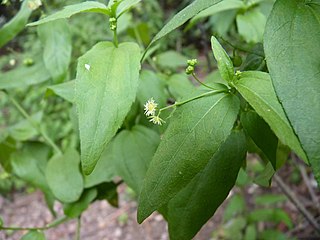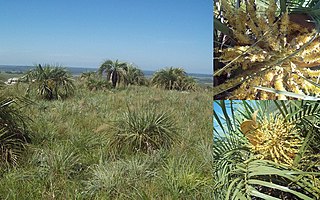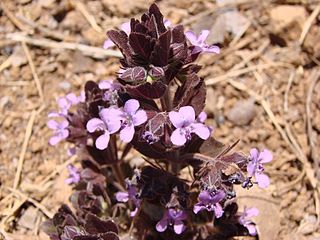
Nothoscordum is a genus of New World plants in the onion tribe within the Amaryllis family. It is probably paraphyletic. The genus is native to North and South America, though a few species have become naturalized in various parts of the Old World.
Bernardia is a plant genus of the family Euphorbiaceae first described for modern science as a genus in 1754. It is native to North and South America, as well as the West Indies.

Chiropetalum is a plant genus of the family Euphorbiaceae first described as a genus in 1832. It is widespread across relatively dry regions of North and South America from Texas to Uruguay.
Actinostemon is a plant genus of the family Euphorbiaceae first described as a genus in 1841. It is native to South America, Central America, and the West Indies.

Campomanesia is a genus in the family Myrtaceae described as a genus in 1794. It is native to South America and Trinidad.

Dyckia is a genus of plants in the family Bromeliaceae, subfamily Pitcairnioideae.

Oxypetalum is a genus of flowering plants in the family Apocynaceae, first described with this name in 1810. The genus is native to South America.

Hedeoma is a genus of flowering plants in the mint family, Lamiaceae. It is native to North and South America. They are commonly known as false pennyroyals.

Araujia is a small genus of perennial vines in the dogbane family first described as a genus in 1817. The group is native to South America.
- Araujia angustifolia(Hook. & Arn.) Steud. - Brazil, Paraguay, Uruguay, NE Argentina
- Araujia graveolens(Lindl.) Mast. - Brazil
- Araujia herzogii(Schltr.) Fontella & Goyder - Bolivia
- Araujia hortorumE.Fourn. - Brazil, Paraguay, Uruguay, NE Argentina
- Araujia megapotamica(Spreng.) G.Don - Brazil, Uruguay, NE Argentina
- Araujia plumosaSchltr. - Brazil, Paraguay, Bolivia, NW Argentina
- Araujia sericiferaBrot. - white bladderflower, cruel vine - Peru, Brazil; naturalized in parts of South Africa + United States
- Araujia stuckertiana(Kurtz ex Heger) Fontella & Goyder - Cordoba in Argentina
- Araujia subhastataE.Fourn. - Brazil

Taccarum is a genus of flowering plants in the family Araceae. It is endemic to South America. The genus tends to grow in rocky areas.
- Taccarum caudatumRusby - Bolivia, Peru, Acre State in western Brazil
- Taccarum crassispathumE.G.Gonç. - central Brazil
- Taccarum peregrinum(Schott) Engl. - Paraguay, southern Brazil, Misiones Province of Argentina
- Taccarum uleiEngl. & K.Krause - eastern Brazil
- Taccarum warmingiiEngl. - southern Brazil
- Taccarum weddellianumBrongn. ex Schott - Bolivia, Peru, Paraguay, central and western Brazil

Butia paraguayensis is a species of Butia palm tree found in the cerrado region of South America. Its natural range runs from Mato Grosso do Sul and São Paulo in southern Brazil through Paraguay to northern Argentina and Uruguay. It was given the name dwarf yatay palm in English by 2000, and it is locally known as yata'i in Guaraní in Paraguay, or butiá-do-cerrado in Portuguese in Rio Grande do Sul, Brazil.

Herreria is a genus of flowering plants native to South America. In the APG III classification system, the genus is placed in the family Asparagaceae, subfamily Agavoideae.
- Herreria bonplandiiLecomte - Argentina, Paraguay, Uruguay
- Herreria cipoanaRavenna - Minas Gerais
- Herreria glazioviiLecomte - Bolivia, Brazil
- Herreria grandifloraGriseb. - Rio de Janeiro
- Herreria latifoliaWoodson - Minas Gerais, Bolivia
- Herreria montevidensisKlotzsch ex Griseb. in C.F.P.von Martius - Argentina, Paraguay, Uruguay, Bolivia
- Herreria salsaparilhaMart. - Brazil
- Herreria stellataRuiz & Pav. - Chile

Amasonia is a genus of plants in the family Lamiaceae, native to South America and to the island of Trinidad.

Cunila is a genus of plants in the Lamiaceae, first described in 1759. It is native to North and South America.
- Cunila angustifoliaBenth. - southern Brazil, Misiones Province of Argentina
- Cunila crenataGarcía-Peña & Tenorio - State of Durango in Mexico
- Cunila fasciculataBenth. - southern Brazil
- Cunila galioidesBenth. - Brazil
- Cunila incanaBenth. - southern Brazil, Argentina
- Cunila incisaBenth. - southern Brazil
- Cunila leucanthaKunth ex Schltdl. & Cham. - Mexico, Central America
- Cunila lythrifoliaBenth. - central + southern Mexico
- Cunila menthiformisEpling - southern Brazil
- Cunila menthoidesBenth. - Uruguay
- Cunila microcephalaBenth. - southern Brazil, Argentina, Uruguay
- Cunila origanoides(L.) Britton - central + eastern United States from Texas and Kansas east to New York and Georgia
- Cunila platyphyllaEpling - southern Brazil
- Cunila polyanthaBenth. - Mexico, Central America
- Cunila pycnanthaB.L.Rob. & Greenm. - Mexico
- Cunila ramamoorthianaM.R.Garcia-Pena - Mexico (Guerrero)
- Cunila spicataBenth. - southern Brazil, Argentina, Uruguay, Paraguay
- Cunila tenuifoliaEpling - southern Brazil
Eriothymus is a genus of flowering plant in the family Lamiaceae, first described as a genus in 1835. It contains only one known species, Eriothymus rubiaceus. It is endemic to the State of Minas Gerais in Brazil.
Hoehnea is a genus of plants in the family Lamiaceae, first described with this name in 1939. It is native to South America, primarily southern Brazil.

Hypenia is a genus of flowering plants in the mint family, Lamiaceae, first described as a genus in 1988. It is native to South America and southern Mexico.
- Hypenia aristulata(Epling) Harley - Goiás
- Hypenia brachystachys(Pohl ex Benth.) Harley - southern Brazil
- Hypenia calycina(Pohl ex Benth.) Harley - Brazil
- Hypenia concinna(Benth.) Harley - Tocantins
- Hypenia crispata(Pohl ex Benth.) Harley - Goiás
- Hypenia densiflora(Pohl ex Benth.) Harley - Brazil
- Hypenia durifolia(Epling) Harley - Brazil
- Hypenia gardneriana(Benth.) Harley - Brazil
- Hypenia glauca(A.St.-Hil. ex Benth.) Harley - Brazil, Paraguay
- Hypenia inelegans(Epling) Harley - Brazil
- Hypenia irregularis(Benth.) Harley - Brazil
- Hypenia macrantha(A.St.-Hil. ex Benth.) Harley - Brazil
- Hypenia macrosiphon(Briq.) Harley - Brazil, Paraguay, Bolivia
- Hypenia marifolia(Benth.) Harley - Brazil
- Hypenia micrantha(Benth.) Harley - Mato Grosso
- Hypenia paniculata(Benth.) Harley - Brazil
- Hypenia paradisi(Harley) Harley - Goiás
- Hypenia pauliana(Epling) Harley - Brazil
- Hypenia perplexa(Epling) Harley - Brazil
- Hypenia pruinosa(Pohl ex Benth.) Harley - Brazil
- Hypenia reticulata(Mart. ex Benth.) Harley - eastern Brazil
- Hypenia salzmannii(Benth.) Harley - Brazil, Guyana, Venezuela
- Hypenia simplex(A.St.-Hil. ex Benth.) Harley & J.F.B.Pastore - Brazil
- Hypenia subrosea(Harley) Harley - Goiás
- Hypenia violaceaMart.Gord. & S.Valencia - Guerrero, Oaxaca
Hyptidendron is a genus of plants in the family Lamiaceae, first described in 1849. The entire genus is endemic to South America.
- Hyptidendron amethystoides(Benth.) Harley - eastern Brazil
- Hyptidendron arboreum(Benth.) Harley - Guyana, Venezuela, Colombia, Ecuador, Peru, northwestern Brazil
- Hyptidendron arbusculum(Epling) Harley - Brazil
- Hyptidendron asperrimum(Spreng.) Harley - eastern Brazil
- Hyptidendron canum(Pohl ex Benth.) Harley - Brazil, Bolivia
- Hyptidendron caudatum(Epling & Játiva) Harley - Brazil
- Hyptidendron claussenii(Benth.) Harley - Minas Gerais
- Hyptidendron conspersum(Benth.) Harley - Bahia
- Hyptidendron dictiocalyx(Benth.) Harley - Goiás
- Hyptidendron eximium(Epling) Harley & J.F.B.Pastore - Mato Grosso
- Hyptidendron glutinosum(Benth.) Harley - Brazil, Bolivia
- Hyptidendron leucophyllum(Pohl ex Benth.) Harley - southern Brazil
- Hyptidendron rhabdocalyx(Mart. ex Benth.) Harley - southern Brazil
- Hyptidendron rondonicum(Harley) Harley - Brazil
- Hyptidendron unilaterale(Epling) Harley - southern Brazil
- Hyptidendron vauthieri(Briq.) Harley - southern Brazil
- Hyptidendron vepretorum(Mart. ex Benth.) Harley - Minas Gerais

Marsypianthes is a genus of flowering plants in the family Lamiaceae, first described in 1833. It is native to South America, Central America, the West Indies, and southern Mexico.
- Marsypianthes burchelliiEpling - Brazil
- Marsypianthes chamaedrys(Vahl) Kuntze. - from southern Mexico and the West Indies south to Argentina
- Marsypianthes foliolosaBenth. - Brazil
- Marsypianthes hassleriBriq. - Paraguay, southern Brazil, Misiones Province of Argentina
- Marsypianthes montanaBenth. - Brazil
Rhabdocaulon is a genus of plants in the family Lamiaceae, first described as a genus in 1936. It is native to South America.
- Rhabdocaulon coccineum(Benth.) Epling - southern Brazil
- Rhabdocaulon denudatum(Benth.) Epling - Brazil
- Rhabdocaulon erythrostachysEpling - southern Brazil
- Rhabdocaulon gracile(Benth.) Epling - southern Brazil
- Rhabdocaulon lavanduloides (Benth.) Epling - southern Brazil
- Rhabdocaulon stenodontum(Briq.) Epling - southern Brazil, Paraguay, northeastern Argentina
- Rhabdocaulon strictum(Benth.) Epling - southern Brazil, Uruguay, northeastern Argentina













